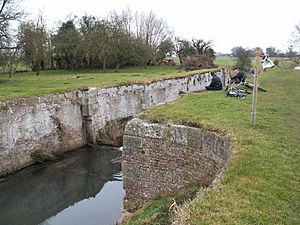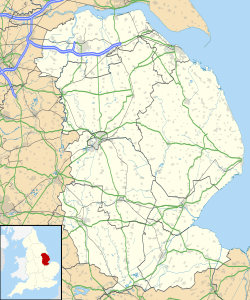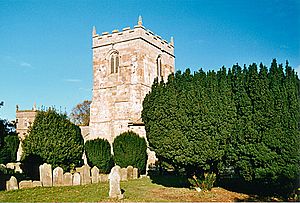Alvingham Priory facts for kids
| Monastery information | |
|---|---|
| Order | Gilbertine |
| Established | 1141 |
| Disestablished | 29th September 1538 |
| Mother house | Sempringham Priory |
| Dedicated to | Saint Mary |
| Diocese | Lincoln |
| People | |
| Founder(s) | Hugh de Scotney, William Friston, Hamelin Alvingham |
| Architecture | |
| Functional Status | Dissolved |
| Groundbreaking | 1148 |
| Completion date | 1154 |
| Site | |
| Location | Alvingham, Lincolnshire, England |
| Coordinates | 53°24′06″N 0°03′22″E / 53.40175°N 0.05614°E |
| Visible remains | some ruins and a chapel |
Alvingham Priory was a special kind of monastery called a Gilbertine priory in Alvingham, Lincolnshire, England. It was founded between 1148 and 1154.
What made Alvingham Priory unique was that it was a "double house." This meant that both monks (called canons) and nuns lived there. They stayed in separate buildings and usually didn't talk to each other. Even their church was divided by a wall! The main leader of the whole priory was the prioress (a nun), and the prior (a monk) worked under her.
Today, not much of the original priory building is left. However, two old churches still stand within the area where the priory once was. Both churches are very old, possibly founded by the Anglo-Saxons.
- St Adelwold's Church is the local parish church for Alvingham. It's the only church in England named after St. Adelwold.
- St Mary's Church was originally a chapel for the priory. After the priory closed, it became the parish church for North Cockerington. It is now looked after by the Churches Conservation Trust.
The priory kept important records in a book called a cartulary, which is now kept at the Bodleian Library. Alvingham Priory was active until many of its residents died from the terrible disease known as the Black Death. People continued to join the priory until the 1500s. At that time, King Henry VIII decided to close all monasteries in England. Alvingham Priory closed on September 29, 1538. After it closed, money was paid to twenty people who had lived there: a prior, seven canons, a prioress, and eleven nuns.
Contents
Where was Alvingham Priory located?

Alvingham Priory was located in the village of Alvingham. This village is mentioned in the old Domesday Book, which was a big survey of England made in 1086. The name "Alvingham" means "Homestead of the Ælfingas" (a tribe).
The village is surrounded by farms. It's on a small road that goes east from Louth, Lincolnshire. In the 1700s, a canal was built near the priory site. Today, this canal is used as a drainage system.
A Look Back: History of the Priory
How the Priory Started (1100s)
The Gilbertine priory of St. Mary, Alvingham, was founded as a double house between 1148 and 1154. It was possibly started by Hugh de Scotney or one of his tenants. Other possible founders include Hugh de Scotney or William Friston.
Another important co-founder was Hamelin Alvingham, also known as Hamelin the Dean. He gave a lot of land to Alvingham Priory. Hamelin even left his job as a dean and joined the priory as a canon (monk). The monks wore black clothes with white cloaks and usually shaved their heads.
In just a few years, the priory owned land in Alvingham, Cockerington, and Calthorp. They also owned the churches of St. Adelwold in Alvingham and St. Mary in Cockerington. These two churches stood in the same churchyard, inside the priory's area. They also owned other churches nearby. Because of all this land and property, St. Gilbert, who founded the Gilbertine Order, set a limit. The priory could have up to eighty nuns and lay sisters, and forty canons and lay brothers.
In 1174, Alvingham Priory made a smart agreement with the nearby Cistercian monastery of Louth Park Abbey. This agreement helped prevent fights over land. They agreed that neither monastery would buy or rent land without the other's permission. This helped them live peacefully together.
Growing and Challenges (1200s)
In 1232, the priory grew even more by buying part of the manor of Alvingham. Before 1251, the priory had many granges (farm estates) in places like Alvingham, Cockerington, and Grainthorpe. They also owned houses or had rents in cities like Lincoln, Louth, Boston, and Great Grimsby.
Like many religious houses, they sometimes helped people who were in financial trouble. In 1232, they bought a large part of the Alvingham manor by helping a family pay off their debt. The priory also had a disagreement with the Bishop of Lincoln about a church, but they won their appeal to Pope Innocent IV in 1245.
In 1291, the priory's income had grown. They made a good amount of money by selling wool, about ten sacks each year in the early 1300s.
King Edward I once asked the priory to consider taking in Gwenllian of Wales and her cousins. These were the daughters of Dafydd ap Gruffydd, a Welsh prince. It's not known if any of these Welsh girls actually stayed at Alvingham. Gwenllian was sent to Sempringham Priory, and her cousin Gwladys ferch Dafydd went to Sixhills.
Later Years (1300s-1400s)
In 1303, the prior held parts of several different areas, showing the priory's widespread land ownership. In 1402, Pope Boniface IX gave a special Indulgence to anyone who visited the chapel of the Virgin Mary in the priory's gatehouse. This meant they could receive spiritual benefits.
In 1448, the prior wrote to the Bishop of Lincoln about the hard times the priory faced. He explained that due to floods, poor land, and diseases among their sheep and cattle, they were struggling. They couldn't offer as much hospitality as they used to. In 1465, Pope Paul II allowed the prior to hold another church position to help with the high costs of running the priory and offering hospitality.
The End of the Priory (1500s)
By 1535, the priory's yearly income was about £128. A good portion of this came from owning churches. The lands farmed directly by the priory were worth £20 a year. All their other farms and properties were rented out.
Around this time, King Henry VIII began the Dissolution of the Monasteries. This was when he closed down all monasteries in England. Alvingham Priory was officially surrendered on September 29, 1538. Robert Ingelby was the Prior and Joan Barker was the Prioress when it closed.
After the priory closed, its property was managed by the crown. It brought in about £131 a year. This included the churches of Alvingham, Cockerington St. Mary, Cockerington St. Leonard, Keddington, Grainthorpe, and Stainton. It also included farms, lands, and rents in many other places across Lincolnshire.
There is also a seal from the 1200s that belonged to the priory. It is shaped like a pointed oval and shows the Virgin Mary, crowned and seated on a throne, holding the Child Jesus on her left knee.



